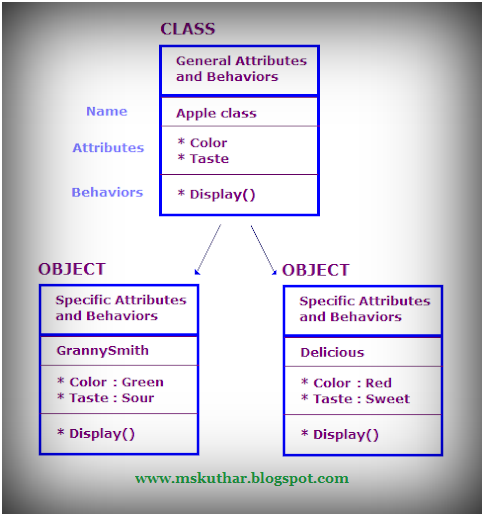Class & Objects
- The mechanism that allows you to combine data and the function in a single unit is called a class.
- Once a class is defined, you can declare variables of that type.
- A class variable is called object or instance.
- In other words, a class would be the data type, and an object would be the variable. Classes are generally declared using the keyword class, with the following format.
class className
{
// some data
// some functions
};
OR
class class_name
{
private:
members1;
protected:
members2;
public:
members3;
};
class class_name
{
private:
members1;
protected:
members2;
public:
members3;
};
- Where class_name is a valid identifier for the class. The body of the declaration can contain members, that can be either data or function declarations.
- The members of a class are classified into three categories: private, public, and protected.
- Private, protected, and public are reserved words and are called member access specifiers.
- These specifiers modify the access rights that the members following them acquire.
- private members of a class are accessible only from within other members of the same class. You cannot access it outside of the class.
- protected members are accessible from members of their same class and also from members of their derived classes.
- Finally, public members are accessible from anywhere where the object is visible.
- By default, all members of a class declared with the class keyword have private access for all its members. Therefore, any member that is declared before one other class specifier automatically has private access.
 |
| Object and Class |
Let us take an complete example
class Circle
{
private:
double radius;
public:
void setRadius(double r)
{
radius = r;
}
double getArea()
{
return 3.14 * radius * radius;
}
};
Object Declaration
- Once a class is defined, you can declare objects of that type. The syntax for declaring a object is the same as that for declaring any other variable. The following statements declare two objects of type circle:
Circle c1, c2;
// Program to understing the working of objects and class in C++.
#include <iostream.h>
#include <conio.h>
class Test
{
private:
int data1;
float data2;
public:
void insertIntegerData(int d)
{
data1 = d;
cout << "Number: " << data1;
}
float insertFloatData()
{
cout << "\nEnter data: ";
cin >> data2;
return data2;
}
};
int main()
{
Test o1, o2;
float secondDataOfObject2;
o1.insertIntegerData(12);
secondDataOfObject2 = o2.insertFloatData();
cout << "You entered " << secondDataOfObject2;
return 0;
}
Expected Output:-
Number: 12
Enter data: 23.3
You entered 23.3
// Program to understing the working of objects and class in C++.
#include <iostream.h>
#include <conio.h>
class Test
{
private:
int data1;
float data2;
public:
void insertIntegerData(int d)
{
data1 = d;
cout << "Number: " << data1;
}
float insertFloatData()
{
cout << "\nEnter data: ";
cin >> data2;
return data2;
}
};
int main()
{
Test o1, o2;
float secondDataOfObject2;
o1.insertIntegerData(12);
secondDataOfObject2 = o2.insertFloatData();
cout << "You entered " << secondDataOfObject2;
return 0;
}
Expected Output:-
Number: 12
Enter data: 23.3
You entered 23.3
Accessing Class Members
- Once an object of a class is declared, it can access the public members of the class.
Defining Member function of class
- You can define Functions inside the class as shown in above example. Member functions defined inside a class this way are created as inline functions by default.
- It is also possible to declare a function within a class but define it elsewhere. Functions defined outside the class are not normally inline.
- When we define a function outside the class we cannot reference them (directly) outside of the class. In order to reference these, we use the scope resolution operator, :: (double colon). In this example, we are defining function setRadius outside the class:
void Circle :: setRadius(double r)
{
radius = r;
}
- The following program demostrates the general feature of classes. Member funcitons setRadius() and getArea() defined outside the class.
#include <iostream.h>
class Circle //specify a class
{
private :
double radius; //class data members
public:
void setRadius(double r);
double getArea(); //member function to return area
};
void Circle :: setRadius(double r)
{
radius = r;
}
double Circle :: getArea()
{
return 3.14 * radius * radius;
}
int main()
{
Circle c1; //define object of class circle
c1.setRadius(2.5); //call member function to initialize radius
cout<<c1.getArea(); //display area of circle object
return 0;
}
